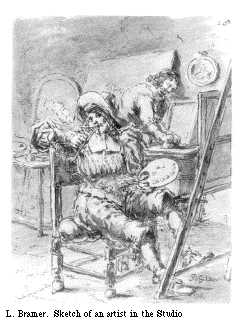

AdC
Abraham de Cooge / Coge (before 1606-after 1680). Important art trader; started off as an engraver, also active as grisaille painter, tulip grower and delftware painter. Born in Haarlem, he lived in Alkmaar and moved to Delft. In Guild in 1632, repeatedly headman. He became a principal dealer in paintings and luxury goods. Owned paintings by Tintoretto, Jordaens, Cuyp.
Paid 21 guilders, the highest amount of taxes of any painter at the end of the 1630's. Some of the sketches in the Bramer album (1642-1654) were made from paintings in his collection. He is known to have sold paintings at annual fair markets in various Dutch and Flemish towns, one recorded instance being Utrecht in 1647 where he sold a portrait by Michiel van Mierevelt. He lived in Delft on Verwersdijk in 1632. He sold a house on Markt, the western half of the present Waag (Weighing House) building. In 1644 he paid 6000 guilders for a house. In 1645 he sold a tulip garden with a shed and beds of tulips near Watersloot for 500 guilders. In 1646 and 1658 he lived in the 'Vergulde Comptoir' (In the Gilded Office) on Verwersdijk at number 6, opposite Choorstraat. In 1668 he was owner of Delft Blue faience workshop De Dissel (The Adze or The Pole), Molslaan number 22.
Bredius, Kunstlerinventare, XI, p. 1513 mentions the Verwersdijk address. Thieme-B. VII, p. 344-345. Cooge ceased painting in 1632 according to Montias in De Stad Delft, 1981. See also Montias Artists & Artisans p. 210. GAD NA 1756 9 January 1658 mentions the 'Vergulde Kantoor' on the Choorstraet; private communication by Montias, 2000. Bredius Kunstler-inventare, V, p. 1511-1514 mentions a garden shed in his tulip field. Compare Serange. Years inferred by Kaldenbach. Taxes in Montias AA 1982. Obreen, Archief, VII, p. 285 mentions a patent in 1647 and 1648. "Principal" dealer Montias 1980 p. 60, see also Montias 1982 p. 121 and 1996 p. 10. Waag building in GAD Koopbrieven Huiseigenaren, D II E 133. Goudappel, Delft in de 17e en 18e eeuw, unpaginated, mentions 9 names of houses on Verwersdijk between Rietveld and Stads Doelen, the Gulden Comptoir being the third from the corner of Rietveld, the Zwarte Ram (Black Ram) at the corner of Doelen being the last. RKD, Bredius archive, artist folder, mentions docs. 1645; 1646. Bramer: Plomp 1986, p. 81-82. Mentioned as "the most important art trader in Delft between 1630 and 1680" and as trader during fairs by Jaap van der Veen in 'De Delftse kunstmarkt in de tijd van Vermeer" in De Hollandse Samenleving in de tijd van Vermeer, Zwolle/The Hague 1996, p. 129-130. De Dissel in Delfts Aardewerk, Zwolle 1999, p.289.
This page forms part of a large encyclopedic site on Delft. Research by Drs. Kees Kaldenbach (email). A full presentation is on view at johannesvermeer.info.
Launched 16 February 2005; Last update March 1, 2017. More info in the RKD site.